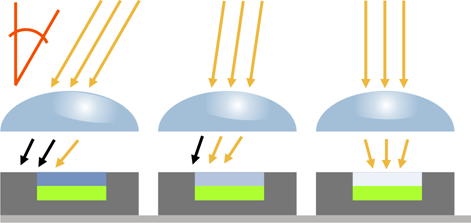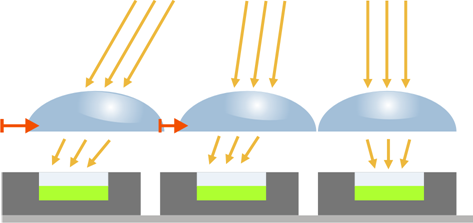IDS Software Suite 4.96.1
Micro lenses improve the fill factor
The fill factor is the percentage of the pixel area that is exposed to light during exposure. Ideally this would be 100 %. Since other elements are located on the sensor surface besides the light-sensitive photodiodes, this value may be reduced to approx. 30–50 %, depending on the sensor technology. The use of micro lenses compensates for this and increases the fill factor to 90 % or more. Micro lenses collect the light that falls onto a photocell, thus increasing the useable sensor area.

Fig. 12: Using micro lenses to increase the effective fill factor
Fig. 13: CMOS pixel design with Bayer filter (red) and micro lens
Micro lenses with CRA correction
Some sensors have micro lenses offset to the sensor edge. They compensate for shading created by obliquely incident light. The angle of incident light is called Chief Ray Angle (CRA), the micro lens offset is thus called CRA correction. The amount of micro lens shift is specified in degrees and refers to the micro lenses in the corners of the sensor.

Fig. 14: Micro lenses without CRA correction

Fig. 15: Image captured without CRA correction shows shading

Fig. 16: Micro lenses with CRA correction

Fig. 17: Image captured with CRA correction
|
Using parallel light on sensors with CRA correction may cause slight color variations. These may occur, for example, if telecentric lenses are used. Which sensors have offset micro lenses can be found in the Camera and sensor data. |
